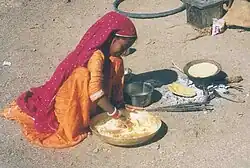Gadia Lohars (also known as Gaduliya Lohars or Lohar) are a nomadic community of Uttar Pradesh, India. They are also found in the Malwa region of Madhya Pradesh. They are lohar (ironsmith) by profession who move on from one place to another place on bullock carts, which in Hindi are called gadi, hence the name 'Gadia Lohar'. These Lohars are different from the Lohar clan of Iran, Pakistan and India. They usually make and repair agricultural and household implements.
Their forefathers were blacksmiths in the army and the Lohar claim to be descendants of Maharana Pratap of Mewar. When Mewar fell to the Mughals, Maharana Pratrap ran to the forest where he met these people who helped him and his family. They pledged never to return to their homeland, never to settle anywhere else, and never to live under a roof until Maharana Pratap won Chittorgarh back. But Maharana Pratap did not win Chittor back and hence the Lohars continue their pledge even today.
Title and Gotra in Gadia Lohar Rajput:
Documentaries
A documentary on them entitled "Gadia Lohar: A Life and Livelihood in Question?" (Hindi/Mini DV/ 24 minutes / 2005/) was filmed by director Meenakshi Vinay Rai.
Another documentary is India's nomads: The forgotten world of the Gadia Lohar (Netflix, 2020) 52 minutes, by Deana Uppal.[1]
See also
- Uttar Pradeshi people
- Romani people
Further reading
- Cobas Puente, Esteban. The Gaduliya Lohars: India's wandering blacksmiths. UNESCO Courier, October 1984.
- Davindera, S. (1997). Socialization and Education of Nomad Children in Delhi State. Regency Publications. ISBN 8186030441.
References
- ↑ Deana Uppal shoots film on the gaddia Lohars. DNA India, March 18, 2019.
External links
- Lancaster, John. India's Lost Nomads. National Geographic, February 2010.
- Photos of Gaduliya Lohars (Loupiote)
